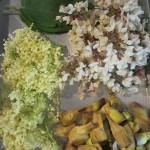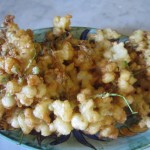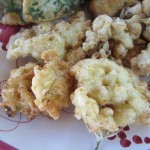 All the members of the squash family – zucchini, squash, pumpkin – put out an edible flower, which in the summer in Italy is easy to find and not expensive to purchase. The zucchini flower is the hardiest and largest, making it ideal for stuffing, while squash and pumpkin blossoms tend to be more delicate and small.
All the members of the squash family – zucchini, squash, pumpkin – put out an edible flower, which in the summer in Italy is easy to find and not expensive to purchase. The zucchini flower is the hardiest and largest, making it ideal for stuffing, while squash and pumpkin blossoms tend to be more delicate and small. 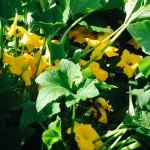
 The best time to pick the flowers is in the morning when they’re open. The flowers you want are the males on a long stem; keep a couple inches of the stem, it’s edible and is nice and crunchy when fried. Be sure to leave one male flower per plant to ensure continued pollination of the female flower.
The best time to pick the flowers is in the morning when they’re open. The flowers you want are the males on a long stem; keep a couple inches of the stem, it’s edible and is nice and crunchy when fried. Be sure to leave one male flower per plant to ensure continued pollination of the female flower.
The female flower will have a small zucchini attached to it. 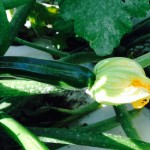
Shake off any bugs or bees, remove the spikes at the base of the flower, and remove the stamen. The flowers will close up and slightly shrink after an hour or two and if you wait to remove the stamen you’ll end up having to rip through the flower to get inside. Be careful not to crush the flowers – I always carry a basket rather than a bag.
The flowers fried on their own are traditional and really delicious, but If you want to stuff them, do it immediately when you get home. Once the flower has closed up it will be difficult to stuff them without ripping the blossom. Just keep the stuffing simple so as not to overwhelm the delicate flavor of the flowers. Instead of stuffing the flowers, my grandmother always put a sprinkling of Parmigiano or Pecorino Romano cheese on top after they were fried!
This is a true summer treat and it’s not too late to find a farmer or a zucchini field to forage!
Fried Zucchini Flowers
Zucchini flowers can be stuffed with sage and chopped fresh pecorino for a delightful Tuscan flavour. A more southern Italian taste is mozzarella and a piece of anchovy. If you don’t wish to stuff them, just dip them in the batter and fry.
Zucchini flowers, cleaned 2-3 per person
Batter for frying (see recipe)
Peanut oil for frying
Clean the zucchini flowers by removing the spikes on the outside at the bottom of the flower and the stamen inside. It’s best done when the flowers are open in the morning, but if they are already closed when you get them, just be careful not to rip the flower too much.
For sage and pecorino, mince 2 tbsp pecorino and 3 sage leaves together in a small bowl and stuff the flowers with about a teaspoon of the mixture. For mozzarella and anchovy, simply put a small piece of anchovy on a long wedge of mozzarella and insert it in the flower.
Batter for Frying 
2 cups AP flour
2-3 cups white wine
1 teas sea salt
Put flour and salt in a bowl, with a whisk begin adding the wine, whisking vigorously to break up any lumps, until the mixture is the consistency of a thin pancake batter. Allow to sit for a few minutes. Line a baking dish with paper towels.
Heat the oil on a high heat until a drop of batter fries and browns quickly. Dip each flower in the batter and drop in the hot oil. Using tongs, turn the flowers when they’re golden brown on one side. If they get too brown too quickly, reduce the heat. If they take a long time to brown, leave the pan empty while the oil comes back up to temperature (350′).
A generous sprinkling of grated Parmigiano is delicious. Serve with a dry cold white or rose’ wine!

